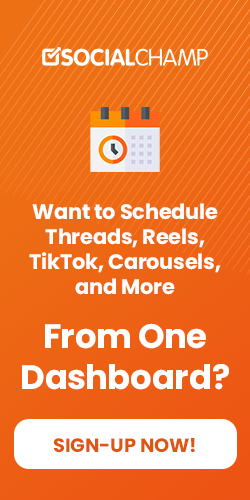Social Media is a pillar of most digital marketing and acts like the backbone of all businesses online. No matter if you are just a startup or an established business, you should definitely focus on building your social media.
However, social media can be quite a challenge at times and it gets super hard and overwhelming to come up with amazing social media campaigns and run them successfully.
This is why we decided to ask professional digital marketers as to what is that one thing that allows you to run and execute their social media marketing campaigns.
So let’s go!
Experts on How to Execute a Social Media Campaign
Ravi Davda
CEO at Rockstar Marketing
“As a small business owner, scheduling tools are important for our social
media content. We have multiple business profiles, and I’m also fairly
active and post personal content on my LinkedIn profile. This wouldn’t be
possible without a tool. For both, it’s also important to have content
going out at different times of the day so it’s viewed by different people.
Tools are good for this, also.
Creating content outside of the actual platform means fewer distractions
too. I remember in the past, I would go onto social media to post, and 30
minutes later, I’m still reading someone else’s posts.”
——————–
Kathy Bennett
CEO and Founder at BPKC
“The most important part of our social media strategy is to get deep into
the psyche of our audience. This is very crucial for us because we firmly
believe in that divine relationship between our product and its audience
and we do our best to enhance and amplify it.
That being said we work firmly on the basis of the following three
principles that have worked wonders for us:
1. Stats: We are very much into testing and understanding the timeline of
our audience, the level of engagement on specific days, and other
paraphernalia – basically a lot of nerdy stuff that really helps us step up
our game.
2. Content Is King: We believe that good content never gets wasted mainly
because you can always reuse the content and its variations and it will
save you a tonne of time.
3. Follow The Trend: The world is evolving and we are in-step with it. We
look out for trending ideas and try to come up with our own variations of
them and it makes social media a lot more interactive.”
——————–
Robert Johansson
CEO and Tech Expert at ImgKits
“Decide how to promote the campaign on each channel:
It’s now time to figure out what kind of material you’ll need for each
social networking platform. For Facebook and Instagram, you might wish to
make a short video.
A unique banner image is required for a Facebook event.
You might also need to take photos for social media sites like Twitter and
Pinterest. To make this process work, you must first understand the
function of each channel. If you want people to see and connect with your
posts, you’ll need to invest in social media advertising.
Start with one
social media channel and experiment to see what works best for your
audience and content if you haven’t used the advertising capabilities
specific to each one yet.“
——————–
Lucas Travis
Founder at Inboard Skate
“ADS: Ads are a very powerful tool that enables businesses to expand their
brand’s goal. Thus, this is my way of expressing my ideas on social media
as well. It’s how I promote my brand and increase brand awareness. However,
there are factors to consider to make it effective. It should be
straightforward, catchy, interesting, and informative. Most people ignore
ads, which is why I made sure to elevate the way I deliver it to gain
attention, instead of being disregarded or skipped.”
——————–
Alec Pow
CEO at The Pricer
“Baseline Metrics: It’s crucial to establish a baseline, even if no one interacts with your Facebook fan page and only your workers share your information on Twitter. The entire purpose of creating a baseline — no matter how horrible the figures appear — is to prepare the audience for when the numbers improve. Don’t worry if you don’t have reporting and analytics tools yet (or if IT is still conducting its months-long needs analysis), it’s perfectly OK to simply open a spreadsheet and start tracking some social media indicators.
Benchmarks of Competitors: You’re not following in the footsteps of others. This is great practice for the same reason you should collect baseline measurements in #1 above. It’s not always easy to define what success in your social media campaign looks like, and competitors are an easy (and entertaining) target. Whatever you do, don’t assume that just because a rival appears to be well-organized, they actually are. Follower numbers, engagement, and a well-designed presence are frequently the product of sheer persistence rather than the execution of novel ideas.
You might also try using a per capita approach to account for relative rival size in your benchmarks, such as dividing by the number of employees or — if you’re a medical group, for example — the number of sites. A B2B healthcare technology business, for example, might be considering entering a new market against larger or more established competitors. When determining the best technique to compare apples to apples, keep this in mind.”
——————–
Darsh Ray
CEO and Founder at Job Alert
“Social Media Goals and Objectives: Because your return on social media is not — and may never be — as cut and white as a PPC campaign, this is typically the most difficult part of the planning process. As a result, you may find yourself justifying some goals that seem soft and others that appear unreachable.
My advice is to keep your goals simple at first, to use both soft and hard goals, and to divide them into buckets or categories. You might set targets for brand exposure, engagement, followers, SEO, and even prospecting and sales standards, for example.
Strategy for Naming: This may seem like a trivial point, but the names you give to your social media accounts are almost as significant as the domain name you chose for your company’s website. This is pretty simple if your company has a unique name. If your name isn’t distinctive, expect to go through brainstorming, searching, brainstorming again, searching again, consensus building, and eventually selection process. The name of the game in the early days was consistent across platforms; but, as more businesses embrace social media, obtaining your exact URL, brand name, and social handles across all platforms is becoming increasingly difficult. However, this is a chance for businesses to think about how they should adapt their brand to each platform.
Twitter, for example, favors brevity: is there a shorter form of your name that might be more appealing to the Twitterati? Facebook is friendlier and less formal. LinkedIn remains (for the time being) a business-oriented platform. We’ve moved past the days when every name on every platform had to match perfectly, so use this as an opportunity to loosen up the brand bible and lean into each platform’s unique eccentricities.”
——————–
Emily Appelbaum
Contributing Writer at Family Destinations Guide
“Creating a good social media campaign is all about trial and error.
We can’t be too sure about what social media users tick. To manage this
ambiguity, we should be testing different campaigns and focus our time
and resources on those that worked. If a campaign has a good history,
there is a higher chance to perform well in the future.
A good testing method is to post something on social media and see if
it will gain good engagement. If it clicked, then it would be wise to
design our campaign based on that. The best thing about this is it’s
free. Testing paid campaigns can be expensive.”
——————–
Alex Mastin
CEO and Founder at Home Grounds
“RELEVANT AND UP-TO-DATE CONTENT
Using the right platform here becomes extremely important for smooth user experience. Different platforms will work for different purposes, for example Flash does not work as well on mobile while Responsive HTML5 automatically reformats itself for different sizes and changes depending on the orientation of the device. You can also consider using PDF’s as quick way to produce content.
INCLUDE SOCIAL MEDIA
Using social media has become the norm, it is one of the most effective ways of creating a sense of solidarity and beginning the usage of something more effective for your organization. This will allow you to transform your
mobile learning experience into an engaging and interactive social learning experience. Collaborate learning tools, social networks, and group activities will bring all the members of your organization together and foster an engaging learning environment, making it a much more enjoyable learning experience for everybody.
ENCOURAGING FEEDBACK
Dynamism is an important element when designing a mobile learning course, this is why feedback is crucial. User feedback offers invaluable insight on what changes should be made in the course and how to overcome certain challenges.”
——————–
Adam Ng
CEO and Founder at Trusted Malaysia
“Creating an idea for your social media channel largely depends on two
things – your expertise, and your audience. Your expertise will help you in
identifying the information you can share, and your audience will inform
you about how you can do that for maximum impact.
For instance, if you are a business that deals with travel you know the
information you have and your audience, how do you go about creating ideas
and executing them?
For starters make a list of all the ideas you have for your social media
posts, make a comprehensive list. Secondly, identify time-sensitive ideas
which revolve around festivals or certain specific days which you can
leverage for traction. Now, delve deeper into your ideas. Which ones are
sharing valuable information for your audience, which ones are merely
engagement tools, and which ones are directed to generate leads.
Once you have identified these sections, get to content creation. Brevity
is the key when it comes to social media, long-form content is still in
vogue in some areas of business, but largely short-form rules the roost.
Keep your information crisp, and beautifully presented. Use professional
content writers and designers to help you create the final product, but if
you have been able to lay down the ideas right the final product becomes a
breeze.”
——————–
Chris Nddie
Co-Owner and Marketing Director at ClothingRIC
“Our organization doesn’t do any long-term planning for social media.
Instead, we closely monitor the trends on forums like Twitter and
Instagram. We piggyback on these trends and try to get our word out. We
keep our goals realistic and consider minimal engagement as a win.“
——————–
Harriet Chan
Co-Founder at CocoFinder
“Initially, you must start your campaign journey with a proper understanding of the goal. What do you want to promote or drive attention for any specific event on the social media channel? Later work on it individually based on the chosen medium of the campaign. For example, Facebook has a different approach to reach the audience, and Twitter adopts another strategy to attract customers.
During the campaign, do not forget to include visual posts to grab the attention of the users. The picture speaks a lot more than words. The advent of social media has led to the demand for visual content. Next, you must draft a scheduled calendar for a week or month to post the relevant ideas on the social media wall. Quickly monitor the responses and address the queries on time to add reliability to your campaign. At regular intervals, analyze your moves and adjust according to the competitive market. These are the unique steps to create and bring the ideas into execution for social media campaigns.“
——————–
Michelle Halpern
Founding Editor and Photographer at Live Like It’s The Weekend
“My go-to strategy is the use of one message spread via different forms of
content. Visual media is the sort of content that brings most visitors to
my site since videos and pictures evoke vivid descriptions of deals and
other content.
Making it on social media requires posting trendy, relevant, and unique
content on a regular basis. Scheduling software has come in handy to make
sure my site constantly attracts visitors seeking good quality and
interesting content.
Monitoring and responding to feedback is important when managing social
media campaigns. Since the goal is to create valuable and relevant content,
getting the views of visitors to the site enables content creators to
optimize content for their audience.”
——————–
Adil Advani
Senior Digital Marketing Strategist at PureVPN
“The process for bringing an idea into execution is as follows:
1. Brainstorm Ideas
2. Pick a few ideas that resonate with you the most
3. Research those projects and decide what to do next based on personal
favorites or unsolved pieces from those projects
4. Pick one that speaks to you the most and follows through until
completion, revising as needed throughout the process, even if it doesn’t
take off immediately.
I enjoy being creative, learning about new technologies, coming up with new
ways to engage our audience and how they can be applied to my work, and
travel as often as possible to experience different cultures firsthand.”
——————–
Bryce Bilello
Founder and Content Creator at Bryce Kathleen
“There are a few ways that I start creating content, it usually starts with
the product. For instance, I recently did a collaboration with Get Rael and
their facemasks. The challenge was I had to feature all 4 of the face masks
and a before and after in a short 15 seconds, IG reel-styled video. With
this in mind, I came up with a reel that had 4 short clips featuring the
face mask and then a cool transition of me with the facemask on and then
after!“
——————–
Patrick Crane
CEO and Founder at Love Sew
“My team and I normally rely on social listening when coming up with ideas for our social media campaigns. Social listening helps us identify topics that our target audience is talking about and the challenges they are facing. We then use this information to craft content that is specifically suited for our customers’ needs at that particular moment. Social listening allows us to create campaigns that are in rhythm with what our clients need, leading to higher engagement, greater conversions, and increased customer loyalty.”
——————–
Sai Blackbyrn
CEO and Founder at Coach Foundation
“When it comes to creating ideas for social media campaigns, my team and I
heavily rely on industry newsletters during our brainstorming sessions. We
find that these newsletters are a great source of evidence-based customer
trends and insights that provide guidance on the substance and direction of
our campaigns. We often spend 3-4 hours a week on these brainstorming
sessions, allowing us to have a constant flow of highly impactful ideas in
our social media campaign pipeline. Often, the ideas with the most votes
from the team are the ones that will be executed.“
——————–
Julie Navickas
Public Relations Manager at Burning Soul Press
“When I am tasked with bringing the ideas of a social media campaign to
fruition, the first place I start is with people. I interview stakeholders,
capture candid photos, compile quotes that resonate with readers – and
above all, I focus on the human element. People like to read about people.
And that’s the core of any social media campaign.
I’m a huge advocate for the design tool Canva and appreciate the platform
Later to help keep me organized posting across multiple platforms.
Analytics are key – and hashtags can make or break any campaign.
*Social media can be quite overwhelming, but when the right strategy and
approach is in place, it’s a remarkably rewarding way to tell a story for
any organization.”
——————–
Katherine Brown
Founder and Marketing Director at Spyic
“In my opinion, the most important thing to remember when we are starting a campaign is to have an idea. We think about what kind of product we are trying to promote, analyze the audience we target for this campaign, and figure out which social media network will be best for reaching that audience.
Some campaigns might require both Facebook and Twitter, while others might only need one or the other. I like to make a plan and logic for what I will do regarding each social media network once we have our idea in mind and we want to make it happen.
What we need in creating our campaign is a plan, and then we can either go into execution with that plan. If you don’t know where you are going, the directions might get confusing. So start with an idea and move forward from there.”
——————–
James Sun
Founder at Beauty Tap
“To create and bring ideas into execution for social media campaigns,
analyze what competitors are doing to achieve success. Follow their methods
and apply them to your business accordingly. Additionally, you can manage
your campaigns by using images or text and staggering posts. This ensures
that you’re creating posts on a regular basis.”
——————–
Alix Greenberg
Founder at ArtSugar
“ArtSugar is a founder’s brand. I live and breathe my business. As such,
our social media content creation is organic. Art plays a significant role
in our daily lives, so our posts evolve naturally as we go about our day.
Whether we’re fulfilling orders, serving up lunch, or waiting at the
airport, we’re showing our audience how art is all around us and often
takes center stage in the simple things we all do.
This makes our social
media content relatable, not rehearsed. If we were to create a social media
campaign or develop a strategy, we’d lose that authenticity that helps
connect us with our audience.“
——————–
Jas Banwait Gill
Growth Manager at Snack Magic
“Our social media is organic. We find that actively engaging our audience
is the key to keeping our audience genuinely interested and authentically
engaged. By answering their questions, leaving thoughtful comments on their
posts, and sharing their content, we’re interacting with our community
members and not just expecting them to follow us.
And by creating
conversations and small group chats to connect our followers, we’re
building up our Instagram community. So engage with your audience
regularly. By doing so, you’ll not gain a loyal following but you’ll also
build a community for your brand.”
——————–
Summer Romasco
Brand Strategist and Marketing Director at Ad Hoc Labs
“Getting creative with your social media retargeting ads can significantly boost engagement and increase conversions while keeping you within your social media marketing budget. Since your remarketing audience previously visited your website without purchasing, they’re already familiar with your brand and your product but may have some hesitations about buying. And it’s the reason why they didn’t follow through with a purchase that should be the focus of your retargeting ad.
By delving into your eCommerce analytics, you’ll discover what products and categories prospects looked at, what pages they visited, and how often they visit your site. This data may indicate what’s holding them back from converting. And reading through your online reviews will let you know what people are saying about your product. With this information in hand, you can craft clever ad copy focusing on your prospects’ concerns and provide the answers that will convert them from hesitant shoppers into loyal customers.”
——————–
Bryan Philips
Head of Marketing at In Motion Marketing
“Creating content and strategies for social media marketing can be tricky..
There are so many things to consider, such as what platform you are
producing for, how you will be promoting, and of course, what your content
actually is. With sites like Facebook and youtube, you can run longer-form
video ads, as watch time and retention, are higher there, whereas on TikTok
you need to be formatted with your researched hashtags and shorter videos.
Your content needs to be informative, but not overly educational, and show
the customer what problem you are solving for them.”
——————–
Erin Sullivan
Digital and Inbound Marketing Manager at University of Advancing Technology
“On the very foundational level, I plan out a month of content based on what’s happening during that month/holidays/etc., however, if you’re in the social media world you know there is a lot you can’t plan. You can’t predict what’s going to trend or what’ll take you viral. How I bring most of my ideas to life is to act quickly.
When I see a trend I know will work for my account, I first think about if I have anything I can pull from my past content (pictures, videos, etc.), and if there is nothing, I go out and find the shots I need. So much of social media is “right time, right place,” and the best way to create is to simply always be ready. You’re always going to have times where you hit a creative block, but over time, you learn how to spin trends and content to fit your brand/company more easily.”
——————–
Mike Nemeroff
CEO and Co-Founder at Rush Order Tees
“There are three steps to successful execution:
Idea generation: Don’t leave this entirely on your social media person.
Encourage others from across departments to suggest topics with a simple
mantra: What’s interesting?
Planning: The best campaigns are planned month-by-month, not
week-by-week. You want an overarching campaign that ties together, so when
someone finds a post that interests them, they’ll see other relevant
content in the feed.
Monitoring: Always look at the data! Track link opens, engagement,
impressions, reach—these metrics show you what to emulate for next time,
and what to avoid.”
——————–
Laura Rike
Pinterest Strategist
“The way we create and execute our social media campaigns really depends on the client. We have a vast array of clientele whose niches are in a variety of areas, and whose goals are different. One business may be hoping to grow their email list, while another hopes to increase sales, while another may just be seeking more views, and our strategies would vary for each desired outcome, and of course, tailored for that specific type of content and subject matter.“
——————–
Joel Almazar
Administrative Assistant at Upgrow
“Investigate new methods to use the big social media platforms. Take the time to review the stats to determine what worked and what didn’t. Perhaps all of the early morning postings did exceptionally well, while your mid-afternoon ones were a complete failure. Alternatively, one form of visual material or messaging received more engagement than the other.
Then use everything you’ve learned to your next campaign’s strategy. Create social network profiles and fill them with high-quality content. Invite friends to join on the journey. Post on a regular basis and create an editorial calendar to help plan ahead of time. Keep track of the progress and keep an eye on competition with one or more social media monitoring tools. Consider using social media tools to assist.“
——————–
Stephen Curry
Owner of CocoSign
“Having great ideas about campaign concepts is a good thing but will be useless if you can take it into reality. As a CEO, I think that the way we execute those ideas is a great factor in having effective social media campaigns.
Creating and executing ideas about social media campaigns undergo the same process with the formulation and implementation of strategies. The first step will be to think of a concept and collaborate ideas of the whole team. Next will be to plan how to create and execute it into reality.
Things to bear in mind as you do this are to have a goal and be open to possible developments during the process. There might be aspects or areas where you can accidentally discover better options while executing it. Thus, you should not block those ideas and consider sudden changes as a possibility.“
——————–
Adam Hempenstall
CEO and Founder of Better Proposals
“The first thing you have to do is connect your sales, marketing, and customer support. Marketing often creates content which is not aligned with what the target audience really needs. So, make sure to connect all three teams together so that your marketing team can get the first-hand experience from sales and customer support, who know the customers better than anyone else. That way, you can get tons of amazing social media content ideas just from one meeting.“
——————–
Jignesh Gohel
Founder and CMO at OLBUZ
“See as a business owner there is no dearth of talent but being a human being you cannot please every person or client but somehow you can minimize the drawback and improve your working style in order to provide the best and desired solution to your client. In my opinion, there are few things you need to know and understand.
Understand the objective of the campaign: The objective of your campaign matters a lot in growing your business size. In fact through this, you can set your futuristic needs and manage how to use your resources.
Create a content calendar for the week/month: Developing your content calendar is another way by which you can improve the growth of your business. Content calendar helps you to serve your clients better and on time. It also helps in building trust and shouldering responsibility.
Promote the campaign on each channel: Promoting campaigns on different channels of social media helps you to grow the size of your business reach and relation with your prospective client’s whom you do not know.
Monitor and respond: Monitoring the response earned from clients is believed to be the best and effective way to check the strength and weakness of your brand.
If you follow the aforesaid points I am sure that you will definitely build trust among your client and make them happy.”
——————–
Genma Stringer Holmes
Owner at Holmes Pest Control
“From Social Media Idea to Execution: Since I manage social media for organizations like Rotary International and The Ohio State University, I always speak with leadership and some stakeholders before I present my campaign. Nothing worse than presenting a great idea if top management does not connect with the idea. The campaign is practically dead on arrival when I try to sell it to the marketing team.
It saves me such time and cuts down on the back and forth between everyone else who are not versed on how social media works on a daily basis. Once I get buy-in from the top, I literally create the entire campaign from messaging to template and* then* present each piece to the group. I take down their input on everything from text to color to layout. Nine out of the last ten campaigns, there were very little changes that needed to be made.
I have learned that setting the tone by having the leadership approval from the top on the idea and to be inclusive of the stakeholders create a seamless flow with everyone else and helps stimulate the creative process. By having the campaign at least 75% complete makes everyone feel as if they designed the campaign and they feel super excited when it is revealed internally or to the public. When I win awards for the campaign, I include everyone who gave input. Since learning that winning strategy for presenting the idea, my campaigns are executed successfully!”
——————–
Maria Marchewka
Digital Marketing Strategist at Newswire
“New trends lead to new ideas and before you know it, you have a running Google Doc of more ideas you could ever effectively execute. But, just because you have *a lot *of ideas, doesn’t mean they’re all *good* ideas. That’s why the first step in building and executing a social media campaign is to do your research. Deploy social listening to understand what makes your target audience tick.
What are their interests? Pain points? Questions Next, take a look at your past campaigns and historical data. What worked? What didn’t? What improvements can you make? Now, these are just two factors to consider when vetting an idea, others include seasonality, what’s going on in the world, industry shifts, etc. Once you have a good gauge of where the market’s attention is and the goal of your campaign, it’s time to bring your idea to life.
Use your campaign goal as your North Star and chart a course with the information you’ve pulled from your research to build out your social media strategy. Think about data being in the driver’s seat and creative in the passenger’s seat. Both are working together to get your brand to the final destination…meeting your goal and connecting with your target audience.“
——————–
Lynda Fairly
Co-Founder at Numlooker
“At Numlooker, we start with an idea. We brainstorm, research, and strategize until we get to a point where we feel confident that the plan will get the results that our client is looking for. Then, we take it one step further by writing out what it would look like on social media. We consider different scenarios to be prepared for anything (i.e., negative news about the company) and any possible opportunities (i.e., product launches or special offers).
Once we have the plan for social media, then we need to identify ways to execute it. We work with our clients to ensure that their content is tweeted, retweeted, written about, and shared. We also do market research to see if any additional opportunities could be used for their social media channel. Once the plan is completed and the steps are set up, we focus on executing the plan. We analyze the results from the previous execution to see how we can improve our subsequent performance. We continue this process until we have gotten the desired results from the client.“
——————–
Brandon Hopkins
Founder at DiamondLinks
“We have a team of leaders that come together to discuss social media ideas and campaigns before our social team goes to work bringing them to reality. We are all very in touch with social trends, so we can bring real ideas and continue to push each other every time we meet.
There is a large team of people who come up with ideas, but our social team is in charge of creating and bringing our vision to life. They do what it takes and we trust them to make it happen. While it can be great to have a large team of brainstormers, we know there shouldn’t be too many people doing the actual creating.
There’s a huge amount of trust and understanding between our team and it works quite well!”
——————–
Ray Blakney
CEO and Co-Founder at Live Lingua
“We post videos on our social media channels that ask questions for our followers to answer in the comments. We started promoting videos on our social media this year instead of posts or images and the engagement is over 300% more than those other mediums.
The key, however, on Facebook is to make sure you upload your video to their site and not just share the YouTube link. Facebook does not want anybody leaving their site, so they will restrict your videos’ reach a lot if you just share an external one. For other sites like LinkedIn and Twitter, it is fine using externally hosted videos.”
——————–
That’s all folks!
We would like to thank all those who took out the time to contribute to our article. These opinions open up multiple new outlets for all budding social media managers and first-time campaign runners.
So what do you think? What is that one thing that allows you to run social media campaigns to perfection? Let us know in the comments below!
















































